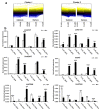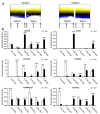Secondary Metabolism and Defense Responses Are Differently Regulated in Two Grapevine Cultivars during Ripening
- PMID: 33802641
- PMCID: PMC8002507
- DOI: 10.3390/ijms22063045
Secondary Metabolism and Defense Responses Are Differently Regulated in Two Grapevine Cultivars during Ripening
Abstract
Vitis vinifera 'Nebbiolo' is one of the most important wine grape cultivars used to produce prestigious high-quality wines known throughout the world, such as Barolo and Barbaresco. 'Nebbiolo' is a distinctive genotype characterized by medium/high vigor, long vegetative and ripening cycles, and limited berry skin color rich in 3'-hydroxylated anthocyanins. To investigate the molecular basis of these characteristics, 'Nebbiolo' berries collected at three different stages of ripening (berry pea size, véraison, and harvest) were compared with V. vinifera 'Barbera' berries, which are rich in 3',5'-hydroxylated anthocyanins, using transcriptomic and analytical approaches. In two consecutive seasons, the two genotypes confirmed their characteristic anthocyanin profiles associated with a different modulation of their transcriptomes during ripening. Secondary metabolism and response to stress were the functional categories that most differentially changed between 'Nebbiolo' and 'Barbera'. The profile rich in 3'-hydroxylated anthocyanins of 'Nebbiolo' was likely linked to a transcriptional downregulation of key genes of anthocyanin biosynthesis. In addition, at berry pea size, the defense metabolism was more active in 'Nebbiolo' than 'Barbera' in absence of biotic attacks. Accordingly, several pathogenesis-related proteins, WRKY transcription factors, and stilbene synthase genes were overexpressed in 'Nebbiolo', suggesting an interesting specific regulation of defense pathways in this genotype that deserves to be further explored.
Keywords: Vitis vinifera; anthocyanin profile; defense metabolism; flavonoid 3′,5′-hydroxylases; high-throughput sequencing; stilbene synthases.
Conflict of interest statement
The authors declare no conflict of interest. The funders had no role in the design of the study; in the collection, analyses, or interpretation of data; in the writing of the manuscript, or in the decision to publish the results.
Figures



Similar articles
-
Secondary metabolites in grapevine: crosstalk of transcriptional, metabolic and hormonal signals controlling stress defence responses in berries and vegetative organs.Front Plant Sci. 2023 Jun 19;14:1124298. doi: 10.3389/fpls.2023.1124298. eCollection 2023. Front Plant Sci. 2023. PMID: 37404528 Free PMC article. Review.
-
Berry skin development in Norton grape: distinct patterns of transcriptional regulation and flavonoid biosynthesis.BMC Plant Biol. 2011 Jan 10;11:7. doi: 10.1186/1471-2229-11-7. BMC Plant Biol. 2011. PMID: 21219654 Free PMC article.
-
Whole-genome sequencing and SNV genotyping of 'Nebbiolo' (Vitis vinifera L.) clones.Sci Rep. 2017 Dec 11;7(1):17294. doi: 10.1038/s41598-017-17405-y. Sci Rep. 2017. PMID: 29229917 Free PMC article.
-
Single-nucleotide polymorphism (SNP) genotyping assays for the varietal authentication of 'Nebbiolo' musts and wines.Food Chem. 2020 May 15;312:126100. doi: 10.1016/j.foodchem.2019.126100. Epub 2019 Dec 26. Food Chem. 2020. PMID: 31901826
-
Brassinosteroid Promotes Grape Berry Quality-Focus on Physicochemical Qualities and Their Coordination with Enzymatic and Molecular Processes: A Review.Int J Mol Sci. 2022 Dec 27;24(1):445. doi: 10.3390/ijms24010445. Int J Mol Sci. 2022. PMID: 36613887 Free PMC article. Review.
Cited by
-
Secondary metabolites in grapevine: crosstalk of transcriptional, metabolic and hormonal signals controlling stress defence responses in berries and vegetative organs.Front Plant Sci. 2023 Jun 19;14:1124298. doi: 10.3389/fpls.2023.1124298. eCollection 2023. Front Plant Sci. 2023. PMID: 37404528 Free PMC article. Review.
-
'Nebbiolo' genome assembly allows surveying the occurrence and functional implications of genomic structural variations in grapevines (Vitis vinifera L.).BMC Genomics. 2022 Feb 24;23(1):159. doi: 10.1186/s12864-022-08389-9. BMC Genomics. 2022. PMID: 35209840 Free PMC article.
-
Hot Water Treatment Causes Lasting Alteration to the Grapevine (Vitis vinifera L.) Mycobiome and Reduces Pathogenic Species Causing Grapevine Trunk Diseases.J Fungi (Basel). 2022 May 6;8(5):485. doi: 10.3390/jof8050485. J Fungi (Basel). 2022. PMID: 35628741 Free PMC article.
-
"Good Wine Makes Good Blood": An Integrated Approach to Characterize Autochthonous Apulian Grapevines as Promising Candidates for Healthy Wines.Int J Biol Sci. 2022 Apr 11;18(7):2851-2866. doi: 10.7150/ijbs.70287. eCollection 2022. Int J Biol Sci. 2022. PMID: 35541898 Free PMC article.
References
-
- Dai Z.W., Ollat N., Gomes E., Decroocq S., Tandonnet J.P., Bordenave L., Pieri P., Hilbert G., Kappel C., van Leeuwen C., et al. Ecophysiological, genetic, and molecular causes of variation in grape berry weight and composition, a review. Am. J. Enol. Vitic. 2011;62:413–425. doi: 10.5344/ajev.2011.10116. - DOI
-
- van Leeuwen C., Schultz H.R., Garcia de Cortazar-Atauri I., Duchêne E., Ollat N., Pieri P., Bois B., Goutouly J.-P., Quénol H., Touzard J.-M., et al. Why climate change will not dramatically decrease viticultural suitability in main wine-producing areas by 2050. Proc. Natl. Acad. Sci. USA. 2013;110:E3051–E3052. doi: 10.1073/pnas.1307927110. - DOI - PMC - PubMed
MeSH terms
Substances
Grants and funding
LinkOut - more resources
Full Text Sources
Other Literature Sources

